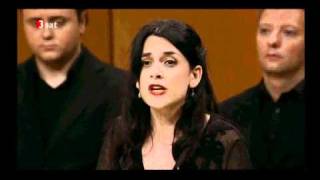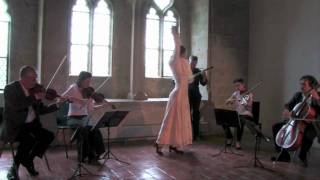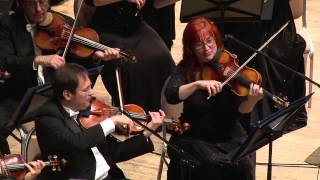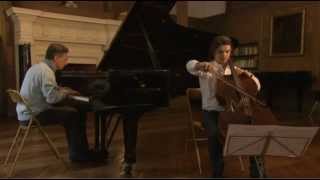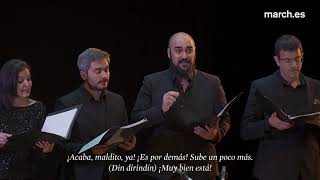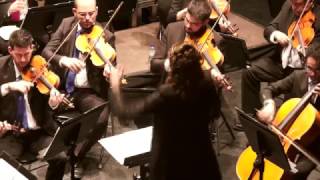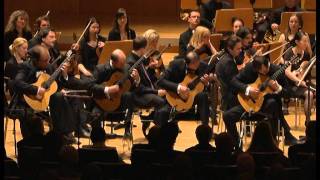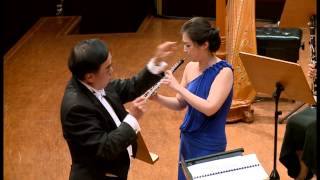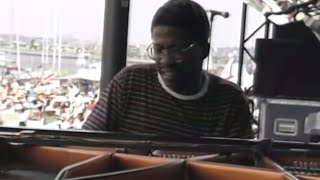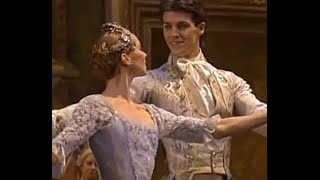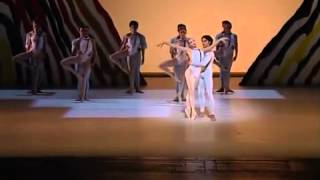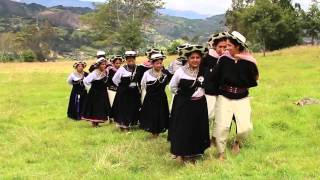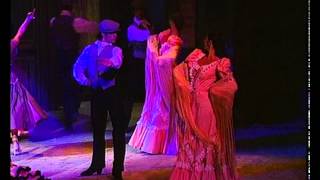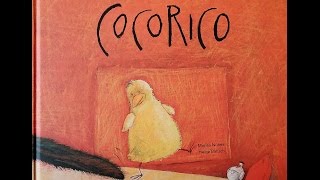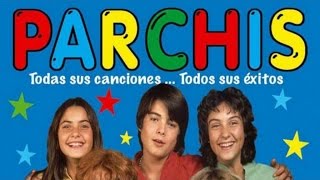Recommended music videos for initiation to classical music
Johann Sebastian Bach (1685-1750) was a German violinist, organist, conductor and composer. He was born in Eisenach into the most prominent musical family in history, with more than 30 famous composers in its midst. In 1703 he obtained his first job as court musician to the Prince of Arndstat and in 1707 he moved to Mülhausen as an organist, where he married his cousin Maria Barbara with whom he had seven children. After the death of his wife in 1720, he remarried Maria Magdalena a year and a half later, with whom he would have another thirteen children. In 1723 he moved to Leipzig, where he would reside until his death at the age of 65. A prolific composer, he is considered one of the three main geniuses in the history of music along with Mozart and Beethoven.
The St. Matthew Passion is an oratorio written by Johann Sebastian Bach for solo voices, double choir and double orchestra. It presents the suffering and death of Christ according to the Gospel of Saint Matthew and is the composer's longest work, although it is divided into two large parts, between which the sermon took place. The narration of the text is sung literally by an Evangelist , the rest of the characters in the plot ( Christ, Judas, Peter , etc.) are embodied by different soloists, the biblical text is set to music in recitatives , while the ariosos and arias present new texts that give a more intimate character to the life of Christ .
Aria , from the Italian aria ("air"), is a piece of music intended to be sung, usually by a solo voice without a chorus, with orchestral accompaniment and as part of an opera, an oratorio or a zarzuela. In ancient times, it was any expressive melody, often, but not always, performed by a singer.
Today we offer the aria Blute nur, du liebes Herz ( Only bleed, dear heart ) performed by the Czech soprano Hana Blažíková accompanied by the Collegium Vocale Gent orchestra conducted by its founder and principal conductor Philippe Herreweghe .
Luigi Boccherini (1743-1805), Italian cellist and composer, whose father was also a cellist; he received his first lessons on the instrument from him. Later, under the tutelage of Vannuci, he perfected his instrumental technique as well as studying harmony, counterpoint and composition. He continued his studies in Rome and after visiting and living in various European cities, he settled in Madrid, where he wrote the majority of his musical production: more than one hundred quintets and another ninety string quartets, as well as trios, sonatas and pieces in other genres; in addition, his repertoire for orchestra includes nearly 30 symphonies and concertos. On the other hand, having been the greatest cello virtuoso of his time, what he wrote for that instrument presents an unprecedented development in the history of music.
Boccherini 's 16 Quintets for guitar form an important legacy of chamber music, of which only nine have been recovered and recomposed. In our time, it is striking that the music for these quintets comes from earlier works by the same composer, a custom that was very much in vogue at that time.
Today we offer the fourth movement (" Fandango" ) from Boccherini 's Guitar Quintet G. 448 in D major performed by the Carmina Quartet with Rolf Lislevand on guitar and Nina Corti on castanets.
Felix Mendelssohn (1809-1847) was a German pianist, conductor and composer of outstanding technical and formal perfection. He was a child prodigy who demonstrated his extraordinary abilities at a very early age and was the brother of the pianist and composer Fanny Mendelssohn , also a child prodigy. He began receiving piano lessons from his mother and at the age of seven he had his own private teacher. At the age of eighteen he began receiving composition classes based on Bach 's Well-Tempered Clavier . Thus, Mendelssohn 's works show a well-established tonal clarity and his fugal passages, a mastery of counterpoint. His legacy includes piano music, organ music, chamber music, overtures, symphonies, concertos, oratorios and incidental music.
The Wedding March (1842) (Hochzeitsmarsch in German) was created by Felix Mendelssohn , for his ballet A Midsummer Night's Dream inspired by the play of the same name by Shakespeare . It is one of the most used wedding marches, usually played by an organ at the moment of the wedding when the bride makes her appearance. It became popularly famous when it was played at the royal wedding of Victoria of Saxe-Coburg and Gotha and the future Frederick III of Prussia , exactly on January 25, 1858. The bride's mother, Queen Victoria , was an admirer of Mendelssohn .
Today it is offered to us by the Moscow Philharmonic conducted by the Soviet maestro Michail Jurowski (1945-2022).
Gabriel Fauré (1845-1924) was a French composer, teacher, organist and pianist, widely regarded as one of the foremost French composers of his generation; his musical style influenced many 20th-century composers. His best-known works include the Pavane , the Requiem , the Nocturnes for piano, and the songs Après un rêve and Clair de lune . His mentors included Camille Saint-Saëns , who became his lifelong friend. When he achieved success, he held the important positions of organist at the Madeleine church and director of the Paris Conservatoire . His legacy has been described as bridging the gap between late Romanticism and the Modernism of the second quarter of the 20th century .
Catalogue of Fauré's works . His works are classified by their Opus number (from the Latin opus 'work'; op. abbreviation) which is a term used in music to catalogue the works of most composers since the 17th century .
Siciliana is a very moderate musical form of dance in 6/8 or 12/8 time, often used in opera and instrumental music in the 18th century . Frequently adopted by Italian or Italianizing composers as a slow movement in concertos, the Siciliana has a character of melancholic sweetness, to which the habitual use of the minor mode and the accentuation of the characteristic rhythm contribute.
Siciliana, Op. 78, is a short work by Gabriel Fauré , composed in 1893. It was originally an orchestral piece, written for a stage production that was abandoned. In 1898 Fauré arranged the unperformed music as a work for cello and piano, and that same year incorporated it into his incidental music for Maurice Maeterlinck 's play Pelléas et Mélisande , in an orchestration for theatre orchestra. It took its final form as part of a suite arranged for full orchestra published in 1909.
Today we offer it in the version for cello and piano with Gautier Capuçon on the cello and Michel Dalberto on the piano.
Recommended classical music videos
Mateo Flecha the Elder (Mateu Fletxa el Vell in Catalan) (1481–1553) was a Catalan Renaissance composer, best known for his Ensaladas . He is called "the Elder" to differentiate him from his nephew Mateo Flecha "The Younger" . He possibly studied music in Barcelona with Joan Castelló . In 1522 he began working at the Cathedral of Lleida , first as a singer and then as chapel master. It is believed that he later moved to Guadalajara , where he worked for six years. He then settled in Valencia and later in Sigüenza , where he was also chapel master. He later entered the Cistercian Order , residing at the Monastery of Poblet , where he would finally die in 1553.
Ensalada is a polyphonic musical genre in which different "ingredients" are mixed in a single piece: musical styles, languages, textures and other elements of music. Styles such as madrigal, popular song, carol, romance, dance, liturgical genres and languages such as Spanish, Catalan, Gascon, Basque ("Vizcaíno"), Portuguese, Italian and Latin appear. In addition, other ingredients appear such as homophony, counterpoint, religious or profane themes, comic, epic, serious or ironic elements and generally different onomatopoeia. It was very popular in the Iberian Peninsula during the Renaissance , especially in the 16th century . The Ensalada was conceived for the entertainment of courtiers and achieved great fame at palace parties.
Today we offer the La Bomba salad by the Renaissance composer Flecha el Viejo, performed by the Spanish ensemble Vandalia .
Franz Joseph Haydn (1732-1809), Austrian composer whose brother Michael Haydn was also a notable composer, was one of the main pillars on which classicism was based (1750-1810). At the age of six he began his studies of harpsichord and violin. At the age of eight he was admitted as a chorister at St. Stephen's Cathedral in Vienna where he continued his musical studies. After losing his voice, he had to survive by working various jobs, while studying composition by analyzing the works of Carl Philipp Emanuel Bach . He maintained a close friendship with Mozart and was Beethoven 's teacher. He laid the main foundations of the sonata form and the formal structure of the string quartet and the symphony . He died at the age of 77 in Vienna .
The catalogue of Haydn's works . The works of Joseph Haydn are now classified according to the system devised by Anthony van Hoboken. Each work is identified by a Roman numeral corresponding to the category, which in most cases is identified by a genre. Some categories have subdivisions, which are indicated by a lower-case letter followed by an Arabic numeral corresponding to the order of the particular work within the category. These numerals are preceded by the word Hoboken (in memory of the author of the catalogue) and sometimes by Hob (his abbreviation).
L'isola disabitata (The Uninhabited Island) is an opera with music by Franz Joseph Haydn and an Italian libretto by Pietro Metastasio ; it premiered at the Eszterháza Palace Theatre on 6 December 1779.
Today the Barbieri Symphony Orchestra conducted by the Spanish maestro Lara Diloy offers us the overture of said opera
Joaquín Rodrigo ( 1901-1999) was a Spanish composer born in Sagunto (Valencia). He went blind at the age of seven; at nine, he began his studies in music theory, violin and piano; at 16, harmony and composition and at 22, he began to compose his first works. At the age of 26, he moved to Paris , where he studied with Paul Dukas for five years. In 1940 he premiered the Concierto de Aranjuez in Barcelona , from which he would become world famous. He was a prolific composer who wrote works for solo instruments, for piano with another instrument, for string orchestra, wind orchestra and symphony orchestra, concertos for different instruments, songs, symphonic-choral works and scenic music, always maintaining a common denominator: the clarity, delicacy and distinction of his music.
The Concierto Andaluz is a work by the Spanish composer Joaquín Rodrigo for four guitars and orchestra composed in 1967, commissioned by Celedonio Romero . The premiere was performed by the San Antonio Symphony Orchestra , the guitar quartet Los Romeros , all conducted by Víctor Alessandro. It took place in San Antonio , Texas on November 18, 1967. The concerto is articulated in three movements: I (0´16´´) BOLERO TIME .-. II (9´05´´) ADAGIO-ALLEGRO-ADAGIO III (19´09´´) ALLEGRETTO-ALLEGRO-ALLEGRETTO.
Today we are treated to the guitar quartet consisting of Nick and David Kvaratskhelia , Peter Ernst and Christopher Brandt , accompanied by the Philharmonie Merck and conducted by Wolfgang Heinzel.
Fernando Ferrer Martínez (Valencia, 1966), known by his stage name Ferrer Ferran , is a Spanish pianist, composer, and band and orchestra conductor. He obtained a degree in wind orchestra conducting from the Associated Board of the Royal Schools of Music and is a professor of composition at the Conservatorio Superior de Música de Castellón . He has composed more than one hundred works, mostly for symphony orchestra, and conducted various bands and orchestras. Throughout his career he has received important awards in recognition of his career in the world of musical composition and direction, both nationally and internationally.
The Magic Forest is a concerto for oboe and brass band written by maestro Ferrer Ferran and divided into three movements. I (0´33´´) THE ELVES .-. II (6´48´´) THE FAIRIES .-. III (12´36´) THE GNOMES. Today it is offered to us by the oboist I-Ching Wang accompanied by the Taipei Wind Orchestra conducted by maestro Leonard Yui-Biau Hou .
Recommended music videos for all tastes
Herbie Hancock (Chicago, 1940) is an American jazz pianist, keyboardist and composer. With the exception of free jazz , he has played practically all the jazz styles that emerged after bebop : hard bop, fusion, modal jazz, jazz funk, electronic jazz , etc.; in 2005 he published the album Possibilities , in which he also approaches dance music. He is a stylistically restless artist who has been influenced by almost all the musical trends of the second half of the 20th century . However, Hancock 's piano and keyboard style are completely his own, with their own urban harmonic traits and particular rhythms. Having studied engineering, he was perfectly prepared for electronics and was the author of two of the most popular jazz works in history, "Watermelon Man" and "Cantaloupe Island" .
Jane Birkin (London, 1946) is an Anglo-French actress and singer who has lived in France since the late 1960s. After her film debuts in the United Kingdom , notably in the film Desire of a Summer Morning , she began a career in France , where she met her later mentor, composer and partner, Serge Gainsbourg . Her weak voice became her trademark and was used intelligently. One of their first collaborations was the song Je t'aime... moi non plus , which became an international hit. In the late 1980s she performed in a series of concerts in Paris interpreting the repertoire that Gainsbourg had written for her. In 2017 she released her thirteenth studio album, "Birkin-Gainsbourg le symphonique".
Today we attended a public recital accompanied by the Lamoureux Symphony Orchestra under the baton of maestro Didier Benetti .
Negu Gorriak («Raw Winters») was an alternative music group founded in Gipuzkoa in 1990. Its influence has been very great in the development of rock both in the Basque Country and in the rest of Spain and France . They have been described as one of the most important rock bands in the Spanish state of the nineties. They practiced a fusion music that pivoted on three fundamental styles for the band: rock, rap and reggae , in addition to traditional Basque music . They maintained a strong political ideology, starting with the choice of the Basque language and continuing both in the way of working and in the subject matter of their songs; as an example, they gave their first concert in front of the Herrera de la Mancha prison. The group dissolved in 1996.
Borreroak Baditu Milaka Aurpegi (The executioner has a thousand faces): 00:00 - Bi doberman beltz (Two black dobermans) .-. 03:43 - NG bada (NG es).-. 04:23 - Bost gehiago (Five more).-. 07:21 - Hipokrisiari Stop! (Stop hypocrisy!) .-. 09:39 - Dollar area .-. 12:30 - Itxoiten (Waiting).-. 16:54 - Dallas-Euskadi 1963 .-. 17:36 - JFK .-. 22:02 - Kolore bizia (Vivid color).-. 25:50 - No problem.-. 26:39 - Sabel-hiztunaren ordu ikaragarria (The terrifying hour of the ventriloquist) .-. 30:35 - Hiltzeko was ugari (Many ways to die).-. 34:52 - Denok gara Malcolm 36:32 - Borreroak baditu milaka aurpegi (The executioner has a thousand faces).-. 42:47 - Rock&Rollaren jukutria (The great Rock&Roll scam) .-. 45:48 - Pistolaren mintzoa (Language of pistols) [cover by M-ak] .-. 48:30 - Erori (Fall).-. 52:39 - Chaquito .-. 56:34 - Euskaldunok eta zientzia (Basques and science) .-. 59:52 - Hemen izango bazina (If you were here) .-. 1:04:24 - Kaixo (Hello-Goodbye) [cover by Delirium Tremens] .-. 1:07:17 - Arrano beltza (The Black Eagle) [cover by Mikel Laboa]
Kiara (Gloria Sabrina Gómez Delgado, 1962- ), is a Venezuelan singer, actress and lawyer. She became known since the late 80's and in the 90's with songs composed by the singer-songwriter and music producer Rudy La Scala . Currently she is mainly dedicated to her facet as an actress, businesswoman and entertainer. In her almost 35-year career as a singer, she has recorded a total of 7 CDs and made various presentations in Venezuela and the rest of the world. She has also ventured into the world of acting, mainly on the Venevisión and RCTV channels, participating in several soap operas. In 2010 Kiara resumed her career as a singer by recording her new album Como La Primera Vez , which includes 6 new songs and 5 previous hits.
Recommended peculiar videos
Pyotr Tchaikovsky (1840-1893) was a Russian composer who graduated from the St. Petersburg Conservatory and wrote works in a variety of musical genres, although his greatest success was achieved with his ballets. Unfortunately, his personal life was plagued by continuous personal crises from the age of 14, when his mother died, also as a result of a repressed homosexuality, which forced him to enter into a marriage that only lasted a few months. He wrote more than 150 compositions, including piano works, quartets, suites, symphonies, concertos, choral works, cantatas, operas and ballets. He died at the age of 53 and is currently considered one of the greatest composers in history.
Sleeping Beauty , one of the most performed ballets in the classical repertoire, is a fairy tale/ballet structured in a prologue and three acts, whose music was written by Tchaikovsky in 1889 with choreography by Marius Petipa and libretto by Ivan Vsevolozhsky and Petipa himself; the plot was based on the tale of Sleeping Beauty , who is a young princess condemned to sleep eternally until true love comes into her life.
Today we offer the entire ballet choreographed by Rudolf Nureyev with Roberto and Diana Vishneva as protagonists accompanied by the Corps de Ballet of La Scala Theatre .
Ludwig van Beethoven (1770-1827) was one of the giants of Western music along with Bach and Mozart . Born in Bonn , his father, of Flemish origin, tried to present him as a second Mozart , although this was a notable failure. Despite this, from the age of nine, the organist Christian Gottlob Neefe captivated him with the study of Bach , whom he would always keep in mind. In 1787 he moved to Vienna with the intention of receiving classes from Mozart , but the death of his mother brought him back to Bonn a few days later. And so, after five years he returned to Vienna where he was able to study with Haydn and Salieri . However, his profession as an excellent pianist could not be realized due to the deafness that attacked him the following year, leaving him totally incapacitated in this faculty.
Ludwig van Beethoven 's Symphony No. 7 in A major, Op. 92, premiered in Vienna on 8 December 1813 and consists of four movements, of which we present today the second movement choreographed by Uwe Scholz and staged on this occasion by Alicia Amatriain with the Stuttgarter Ballet .
The Rumiñahui Group is a cultural group for youth in Tuncarta , Saraguro, Ecuador . The group performs traditional dances of the Saraguro people, as well as men's camps and women's sports teams from the community. Members performed these dances on the hill of Huilimon, with Puglla in the distance. The video was filmed in March 2013 by David Syring and Manuel Benigno Cango and edited in collaboration with group members Freddy Guillas, Leidy Pricila Cango, and Ana Victoria Sarango . Thanks to the group members for their collaboration! Video made using resources from the Participatory Media Lab at the University of Minnesota Duluth. Funding by the UMD Chancellor's Strategic Initiative Grant, The McKnight Imagine Fund, and the UMD College of Liberal Arts. (Excerpt from the bottom of the video)
La Verbena de la Paloma , subtitled The Apothecary and the Chulapas and Badly Suppressed Jealousy , is a lyrical farce in prose with a libretto by Ricardo de la Vega and music by Tomás Bretón , which premiered on February 17, 1894 at the Teatro Apolo in Madrid . Its title refers to the Madrid festivities around August 15, when the procession of the Virgen de la Paloma is celebrated . La Verbena consists of a single act, divided into three scenes, being a prototypical zarzuela of the genre chico, of short duration.
Today we offer the choreography of the Prelude of the Zarzuela in a version by the Alhambra Ballet .
Recommended music videos for children
Various Wikipedia articles have been used to write these texts.
The texts of Videomusicalis are written in Basque, Spanish and English.





